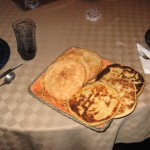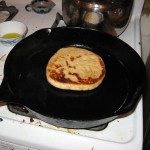Ingredients:
- 1 Cucumber
- 1 Tomato
- 1 Carrot
- Mixed Salad Greens
- Salt to taste
Step 1: Have a seat; you are going to be here for a while. The two main ingredients will be time and attention; the main tools you already have with you: your senses.
 Step 2: Find a good, preferable fresh and local, but really good cucumber. Cut a thin slice or two off it. Hold it up to the light—already the juice from the cucumber will be forming in little drops on the outside. Place it on you tongue, and try to think about the flavor. Breathe through both your nose and your mouth, so you can get the full smell. The flavor of a cucumber is subtle, but unmistakable. Slowly chew it, letting it melt into your mouth. Try nibbling the next one from the outside in—how is the surface, then each layer, different in taste? Try a thicker slice; doesn’t it taste differently? How about if you just take a big bit out of the unsliced cucumber? If you add just a little bit of salt—just a little bit!—how does that change it? If you don’t over-power it, the salt might enhance the flavor.
Step 2: Find a good, preferable fresh and local, but really good cucumber. Cut a thin slice or two off it. Hold it up to the light—already the juice from the cucumber will be forming in little drops on the outside. Place it on you tongue, and try to think about the flavor. Breathe through both your nose and your mouth, so you can get the full smell. The flavor of a cucumber is subtle, but unmistakable. Slowly chew it, letting it melt into your mouth. Try nibbling the next one from the outside in—how is the surface, then each layer, different in taste? Try a thicker slice; doesn’t it taste differently? How about if you just take a big bit out of the unsliced cucumber? If you add just a little bit of salt—just a little bit!—how does that change it? If you don’t over-power it, the salt might enhance the flavor.
Pause.
Slowly finish the cucumber.
Step 3: Take a sip of ice cold Prosecco DOC.
Step 4: Find a fresh tomato, preferably still warm from the sun. 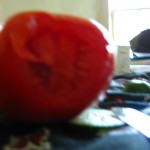 Smell it—the stem and leaves of a tomato have a sharp, harsh scent, and if the tomato is fresh you can still smell them, as if you were standing in the patch (you could, of course, be standing in the patch—that would be even better, unless it is your neighbor’s, in which case, please keep your eyes open).
Smell it—the stem and leaves of a tomato have a sharp, harsh scent, and if the tomato is fresh you can still smell them, as if you were standing in the patch (you could, of course, be standing in the patch—that would be even better, unless it is your neighbor’s, in which case, please keep your eyes open).
Feel the weight of it in your hand, the firmness of the skin as you roll it in your palm. Feel its skin against your cheek, then your lips. Feel the elasticity of the skin against your teeth, and then the sudden give of puncture and bite. Suck in the juice & seeds, feeling them against the back of your throat, swallow and then laugh.
Pause.
Continue as needed.
Step 5: How about another sip of wine? Maybe you should get a napkin to clean up.
Step 6: Find a fresh carrot, and scrub it thoroughly. Take a big bite of it, and chew it  thoughtfully. Is it sweet? Is it bitter? Chew it slowly, breathing, again, through both your mouth and nose, to let the air flow across it.
thoughtfully. Is it sweet? Is it bitter? Chew it slowly, breathing, again, through both your mouth and nose, to let the air flow across it.
Try slicing it thickly. It tastes differently, doesn’t it? Eat it slowly, nibbling from the outside in, and savoring each part.
Try shaving it with a vegetable peeler, and eating the long peelings. Again, it tastes differently this way—more sweet, but also more insubstantial and faint.
Step 7: Eat the salad greens one by one, pausing before going on to the next leaf.  The solid reliability of leaf lettuce, the peppery-ness of arugula, the firm, thick green taste of lettuce—each is different. Try just a hint of salt. Does this enhance, or just mask the flavor?
The solid reliability of leaf lettuce, the peppery-ness of arugula, the firm, thick green taste of lettuce—each is different. Try just a hint of salt. Does this enhance, or just mask the flavor?







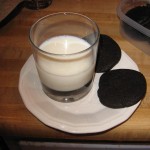



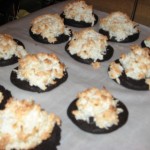
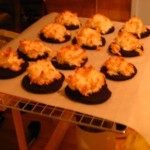


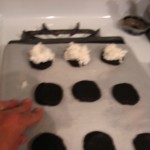




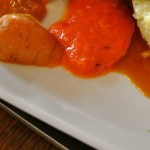




![IMG_2040[1]](http://www.philosophybistro.com/wp-content/uploads/2013/05/IMG_20401-150x150.jpg)
![IMG_2036[1]](http://www.philosophybistro.com/wp-content/uploads/2013/05/IMG_20361-150x150.jpg)


